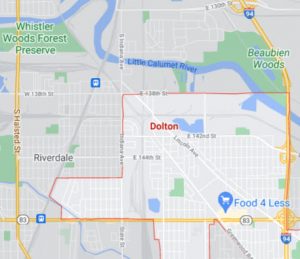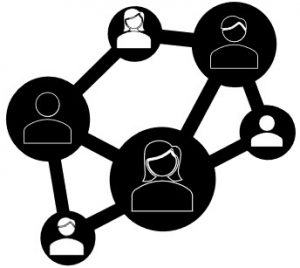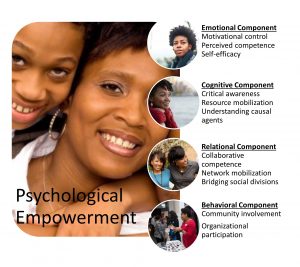11 Journeying Past Hurt: Creating and Sustaining Trauma-Informed Healing Practices With Black Pregnant and Parenting Mothers
Dr. Deidra Somerville, Ph.D.
This chapter explores the process of development for the Journey’s Curriculum, a program designed to center the voices and knowledge of Black pregnant and parenting mothers to support families.
The Big Picture

The Community Exodus
Chicagoans often tell the story of Chicago and Chicago’s suburbs as if they are separate and apart, when their stories are intimately tied together. The fast-changing economic climate coupled with the unrelenting housing and employment discrimination practices affecting Chicago’s Black families reached a boiling point that spilled over into a mass migration to quiet unsuspecting residents of the south suburbs, peaking in the early 1990s through 2010. Surges in crime in Chicago’s Black neighborhoods were in part a result of the movement of jobs from the urban cities in America to urban cities in southeast Asian countries, disrupting and upending the economic fabric in rural communities in the outskirts of major cities in China, India, Malaysia, and Indonesia and shaking up the lives of Black men and women in Chicago’s south and west side neighborhoods. For many Chicago families, moving to the south suburbs was a way to find jobs, safe neighborhoods, and schools with strong academic promise.
As Blacks fled south and further west, White families fled even further south and west, leaving their homes and careers largely in policing and teaching, with the perception that their communities would suffer some wrath untold from their new Black neighbors. Some Black families were able to make the migration work. As the south and west suburban communities changed, the necessary support systems found in large cities were not present in the suburbs. Their absence deeply impacted families, particularly young families. The project discussed in this chapter attempted to support these young families, primarily headed by young Black parenting and pregnant mothers, whose families moved to the south suburbs. They are the first generation of Black children born during the exodus to the south suburbs. They have learned to navigate the systems available to them, much in the way some of their parents did. The project is designed to help them to see the systems that drove their families to the south suburbs and to use different tools to navigate communities existing within persistent disinvestment, White flight, and scarcity. This project took place in a small town that is still working to establish adequate support systems for its largely Black and low-income population. This city is Dolton, IL.

How I (Dr. Somerville) Came Into This Work
My family was part of the mass migration to the south suburbs during the 1990s. Like many others, our family looked for a place that would offer a “good life” for children and a place with peace of mind for ourselves. We found it in South Holland, a neighboring suburb just east of Dolton. I’ve spent most of my waking days working, studying, organizing, and engaging in coordinated responses to oppressive systems affecting Black people and people of color in Chicago, leaving far less time to explore the ecosystem of support for families in my own community. This project presented a unique opportunity to change that. Through volunteering and some consulting work, I’ve come to know and learn more about the nonprofit organizations in the south suburbs. Many operate as storefronts, have offices in bank buildings as a result of community benefit agreements, or operate within churches. Very few grantmaking foundations fund outside of the city limits of Chicago, which means that many of the programs in the south suburbs are funded through fee-for-service contracts with the State of Illinois or large grants that fund federal programs within the local area. Healthcare Consortium of Illinois (HCI) is one of the federally funded operations in the suburbs that accompanied families to the south suburbs in the 1990s.
South Suburban Landscape: Community Needs
HCI is located in Dolton, IL, a village township located in the south suburbs of Cook County. Demographics of Dolton (2010) include the following:
- 88% of the population are African American
- 41% of the households have children under the age of 18; and
- 29% of the households earn less than $25,000 annually.
Like many south suburban Cook County communities, Dolton experienced a significant population shift during the 1990s which resulted in a large exodus of White, middle-income families and an influx of black middle-and lower-income families around the same time. During this shift, many families came to the south suburbs seeking employment and housing opportunities. The challenges with a tight job market, poor transportation options, and poor social service infrastructure made it difficult for many young, under-resourced families to transition well into communities designed to accommodate single-family, working and middle-income families with high degrees of self-sufficiency. According to data on local municipalities collected by the Metropolitan Planning Council of Chicago, low-income, single-parent families in Dolton spend 46% of their income on housing costs and 30% of their income on transportation costs. For mediate and moderate-income families, percentages were significantly lower for transportation costs, at 29% and 35%, respectively. Most residents within Dolton, regardless of their income, find employment in Chicago (39.4%). Unemployment is also much higher in Dolton at 24% compared to the rest of Cook County (10.7%) and the 7-county region (9.5%). HCI’s Healthy Start families are in the eye of the storm of poverty, unemployment, and those overburdened with housing and transportation costs (Encyclopedia Chicago History).

Residents and local leaders living together and working on issues impacting Black children and families in the south suburbs have relied on time-honored institutions within Black communities to address the gaps in resources in the absence of multi-million dollar foundations, corporation foundations, city budgets for supportive services, and a small pool of wealthy individual donors. Many churches have active community outreach ministries. Volunteerism is strong among churches and retirees. Schools and small community centers work with nonprofits and unincorporated organizations seeking collaborators to carry out services, space for programming, or distribute goods and services to the broader community. The web of connections among service providers is intact. Individuals who work for a nonprofit generally know who’s who. There is a sensibility of a “small town” community feel that makes connecting across organizations and municipalities less difficult than for larger cities where there is competition for funding at every turn.
Community Partner: Healthcare Consortium of Illinois
The Healthcare Consortium of Illinois (HCI) is an organization located in Dolton, IL, of partners committed to developing and maintaining targeted, community-based, integrated health and human service delivery systems which increase the well-being of individuals, families, and communities throughout Illinois by means of advocacy, awareness, and action. HCI operates the Healthy Start Program, a federally funded system of services that promotes family-based education strategies that are intended to lead to positive health outcomes for pregnant and parenting mothers and their families. The Healthy Start Program serves neighborhoods on Chicago’s southeast side and communities within south suburban Cook County. This project will focus service delivery on the needs of clients served by HCI’s Healthy Start Southeast Chicago Program.
Development of the Journeys Curriculum

The engagement began in the fall of 2018 with a goal to identify how to best bring the knowledge and experiences of Black pregnant and parenting mothers into training programs for staffers and curriculum designed to support families to get them to the point of thriving. Caseworkers, doulas, lactation consultants, and program managers from the Healthy Start Southeast Chicago Program worked with clients to learn about ways to make sure that curriculum was more than just a way to change behavior, but to acknowledge the systems that are often hostile to clients. They realized that asking clients to constantly acquiesce to unjust systems was indeed unjust and did nothing to improve those systems for their clients. Healthy Start program staff hoped to identify key issues and solutions based on their knowledge of the populations they serve and responsiveness to their presenting issues. At an initial meeting held at the HCI offices with the Healthy Start team, the team shared their current challenges and concerns to develop a meaningful, useful, and relevant project that would best address their concerns together. One key issue found was current curriculum and staff training that focused on behavior modification left many unaddressed systemic issues that clients discussed with staff. The concerns were:
- Case management strategies employed often focused on goal setting and implementing strategies for mobility, which are very often hard to obtain or achieve; and
- Barriers to success were often related to untreated trauma: childhood trauma, rape, prostitution, and intergenerational family dysfunction.
Healthy Start professionals had existing training in several different curriculums over the years, all evidenced-based, as the Healthy Start Program is a federally funded program. The curriculum choices they had at their disposal are not designed to address what staff believes are the root causes that keep their clients from setting and achieving their program goals. They decided that a curriculum that helped to address this current gap in their program practices would be the most meaningful and relevant project to focus on. The staff discussed the curriculum options they used and how they are integral to their work as advocates. A curriculum development chart (see Figure 1) was developed and presented at a follow-up meeting to analyze the curriculum options with the team. The curriculum chart featured underlying treatment goals, curriculum outcomes based on what has been written in peer-reviewed literature, what works for the team, and what is missing. The staff had the final say in how this chart defined the treatment goals and curriculum outcomes. The Staff team also determined what they found most useful for the existing curriculum and what they wanted to see in the curriculum to be developed. Table 1 below shows the Curriculum Development Chart.
Table 1 – Curriculum Development Chart
Curriculum |
Underlying Treatment Goal | Curriculum Outcomes | What Works? | What is Missing? |
| Mothers and Babies | Psychoeducation regarding depression, inner and outer reality management | Stress management
Use of coping strategies |
Decreases effects of depressive episodes Improves self-regulating behavior |
The context for the inner and outer reality management to help young mothers define their lives as beyond coping. A trauma-informed approach is not emphasized. |
| Parents as Teachers | To improve health and early childhood education of children 0-5 years
Improve parental engagement |
Optimal early development of children
Mothers practice the use of tools for self-regulation |
Children are well monitored for health and development improvements | No acknowledgment of the relationships between trauma experienced by mothers and outcomes. No capacity developed for parents to understand past and current trauma and contextualize their current reality |
| Proposed Journeys Curriculum | Treatment of past trauma and addressing current trauma
Psychoeducation |
Goal setting
Placing experiences within the context of structural oppression and system navigation |
Proposal: improved self-regulation; change in perception of the oppressive systems they navigate as reflected in the goals they set for themselves. | Proposal: child development outcomes are not included as part of the curriculum. |
Workshop Processes
The workshopping process involved setting time with the staff to discuss our collective experiences with the current curriculum targeting pregnant and parenting Black mothers. The staff identified the absence of a trauma-informed approach as a clear focus. The team consisted of the program director, 3 case managers, and 2 doulas. The program director and 2 case managers had recently gone through a trauma certification training together a few months prior and shared ideas on how to incorporate our knowledge of trauma-informed practice, both in terms of institutional responses and clinical responses. Staff members discussed the importance of holding space to acknowledge trauma in order to facilitate healing and the use of tools to address trauma. The use of psychoeducation would be an important tool to address trauma and introduce the trauma-informed practice. The entire team acknowledged that they were unclear of the extent to which unaddressed trauma impacted their case management strategies with their clients. Putting together a curriculum with a trauma-informed approach (trauma-informed care) would help them to determine if addressing trauma would indeed have a positive outcome for their work with their clients. The opportunity to acknowledge the impact of intergenerational trauma and the legacy of white supremacy would bring a contextual reality to the curriculum that could inform their work with clients in more meaningful ways (Minnesota State Health Information)
Healthy Start staff were considered knowledgeable and experts in relation to their clients and the community. They were being consulted regarding the problem and issues affecting their clients and the solution that would best address it. The curriculum was designed to emphasize a strengths-based model that reflects aspects of psychological empowerment theory.

Empowerment Theory
There are many aspects to empowerment theory that can be applied to understanding an empowered setting. It is important to emphasize psychological empowerment in the lived experience of clients and Healthy Start staff. The curriculum draws from the four components of psychological empowerment: the emotional, cognitive, relational, and behavior components. Currently, Healthy Start staff saw many of their clients as not having control over their lives, due to all of the systems they must navigate for their daily survival. The curriculum was designed to facilitate the possibility for client participants to experience control and self-efficacy over their lives and relationships with their children. Their self-perception as competent and in control are considered to make a significant difference in how clients are able to make a life for themselves, despite the limitations that come with teenage motherhood.
Intervention Strategies
As a community psychologist, I proposed a set of intervention strategies in response to the goals discussed in prior meetings and what the team felt was missing that needed to be integrated into the curriculum under development. I conducted research and drew from the bank of information that taken together, I was either exposed to or familiar with as part of our shared training in the treatment of trauma. I also took into consideration the experiences discussed with HCI staff would be important to include as part of the curriculum: incorporation of movement (many of the group-based sessions we reviewed together only allowed for everyone to sit for an hour or more at a time, which everyone felt was not wholly conducive to their clients), incorporation of building rapport and connection among participants, and integrating aspects of African-centric practices that can support positive identity development.
The intervention strategies introduced to the HCI team were broken down into 3 pillars of intervention: therapeutic/healing, growth/change, and ritualistic/confronting complacency/waking up the spirit (see Figure 2). Each strategy introduced to the HCI team was discussed in order to introduce the relationship of the theories to the outcomes discussed in earlier conversations. This chart was introduced to begin to discuss the process by which the goals and outcomes would be obtained. This chart would help connect the dots between theory, practice and what HCI staff felt would help best support their current work with their clients. I endeavored to ensure that everyone involved in the decision-making process could see the connection between the “big picture” ideas we explored when looking at different curriculums and our thoughts about them to carve out more specific goals for this curriculum. This part of the journey brought up many feelings for all of us, reflecting on our own experiences in our own healing journeys. We realized that this was not only for clients but could also benefit HCI staff as well. Table 2 below shows the Interventions Strategy Chart.
Figure 2. Interventions Strategy Chart
| Strategy | Reference | Intervention Goal | Intervention Outcomes |
|---|---|---|---|
| Liberation Education | Paolo Freire bell hooks | Growth/change: Engage through praxis and use of critical thinking | Participates in their own life story while healing |
| Re-Evaluation Counseling | Harvy Jenkins | Growth/change: To undermine the effects of traumatic events, affirm and evolve the psyche | Use different perspective to commit to their own ideas about change |
| Rites of Passage | Indigenous African traditions | Ritualistic/confronting complacency/waking up the spirit and therapeutic healing: Restore harmony, justice, balance, and order | Begin to recognize their true selves and to nurture and evolve beyond the constraints around them |
| Radical group work – Circle Work | Kay Pranis Jennifer Ball |
Mark and create sacred space to invoke ceremony, mutual exchange, and healing | Create grounding process to ensure greatest access to healing and participation |
| Narrative Therapy | Dubi | Therapeutic healing: To use storytelling as a means to address past trauma | Use an expressions to release all that has caged their ability to heal from trauma |
The curriculum also aligns strongly with Bronfenbrenner’s ecological systems theory. The curriculum aims to facilitate a process for clients to see the connections among how clients experience their families, community institutions, neighbors, and the macrosystems that support them. The curriculum helps to identify the barriers to healthy family relationships and the need to examine the systems that both impede child and maternal health and support it. The curriculum builds upon HCI’s integrative framework and supports each of its case managers as they work with clients to support their goal-setting towards education attainment, employment, and the emotional health of Black mothers and their children. The use of systems thinking was designed to help HCI staff and clients improve outcomes for mothers and their families.
The Role of Trust
The team members trust in my capacity to take their ideas and shape them into larger constructs that would inform the direction of the actual curriculum development was a bit daunting. I also felt that our conversations about what we would like to see were specific enough that I had a clear road map of how to further crystallize the ideas into an actionable plan and process. I use the term “we” very loosely, as my role during this part of the process was to listen, listen some more, ask clarifying questions, and present the ideas as I received them in order to receive feedback – and then start the process over again.
I did choose to engage HCI staff with my own experiences as well, as co-creators of this work, which is our community psychology approach, particularly when we shared how we each felt about the trauma certification program we experienced together. Thus, this process was largely reflective of their ideas and priorities for the curriculum. The development of trust was about trusting me and the process I provided for the development of the curriculum, but also, it was a process for HCI team members to trust themselves. As many team members have built a career in their roles as case managers, doulas, and in a leadership role of a case management team, they have been charged with implementing curriculum created by researchers/outsiders who generally don’t consult with case managers or program directors, and certainly not doulas, when developing evidence-based curriculum. This was a new role for the team. As we continued to discuss ideas and plans, the ability to see the process move from an interest they shared to the possibility of having a direct impact on the families they served became more real.
The Journeys Curriculum
The curriculum became known as the Journeys Curriculum, a psychoeducation format to address previous trauma while also aligning with current case management strategies for each client/resident to support their individual goal setting. The curriculum was designed as modular to allow for flexibility in implementation, depending on time constraints, client needs, and team member observations of clients. The curriculum could be delivered over 6-12 weeks, 1-2 hours per session. The curriculum incorporated centering, diaphragmatic breathing, and introduction to more techniques over time as the group evolved. Diaphragmatic breathing is a mind-body practice used throughout the curriculum (at the beginning and ending of each session) to reduce stress and has been studied to have additional benefits (https://www.ncbi.nlm.nih.gov/pmc/articles/PMC5455070/). Self-regulation techniques were also shared, along with knowledge of how and why such self-regulation helps the body and mind. Each person visits their own family histories through stories about themselves and their families. This storytelling is interwoven throughout the curriculum.
The content of the curriculum allowed users to center their own stories, thereby having the opportunity to relive their journey with support and to gain conscious awareness of the contextual realities that informed their past, that of their family members, ancestors, and that which impacts their relationship with their children. The stories served as the foundation upon which they viewed themselves and the systems they navigate, their relationships and how they’ve changed over time, through influence of external realities. Participants began to critically examine their relationships and goal setting, and how systems impact their relationship to both. They used a mapping exercise to visualize the systems in their lives and their connections to their children to determine whether they are navigating systems or whether systems are navigating their lives. Exploration of their bodies and how they relate to them – as mothers and as sexual partners, through the trauma they’ve experienced, exploitation, and their earliest memories of their awareness of their bodies was also explored. The curriculum also made space for taking back power from traumatic memories/experiences and connecting them to practices that acknowledge pain from past experiences and incorporate self-regulation exercises to support their healing and continued psycho-social-emotional development. After exposure to various trauma-informed techniques, participants identified which ones they planned to continue to use after the group ended. Affirmation exercises were also used throughout and at the end of each module along with bonding exercises that help to reaffirm and reconnect the group members to one another.
Connections of the Curriculum
Once the co-creation of the curriculum was complete, the staff requested that we go through the curriculum together before working with their clients. They immediately saw the connections between their own experiences and that of their clients, as many of them are also Black women, some with similar origin stories to their clients. Staff members were also moved by the opportunity to grow their knowledge and incorporation of trauma-informed practice into their own work with clients. They saw the modular nature of the curriculum to have a particular benefit in helping support flexibility in use with clients. The techniques also offered a unique opportunity to support staff in unique ways and address untreated trauma that they also experienced. The curriculum has made an impact on the ways that staff members see themselves in relation to their clients and has made room for their capacity to engage in this work for their clients and to find a road to healing for staff who are often tasked with supporting clients, even as their own needs to heal from trauma and past experiences remain unresolved.
We were excited to begin the Journeys Curriculum. However, unfortunately, the project with Healthy Start was sidelined with a number of the staff leaving the agency during the planned implementation period. But, the project has since been utilized with a residency program for Black pregnant and parenting women in Harvey, IL, a neighboring municipality to Dolton, IL. The engagement process is still currently underway, delayed due to mandated restrictions related to COVID-19. There are still plans in place to implement the curriculum.
Takeaways From the Project
This process began with a goal to impact clients of the Healthy Start Southeast Chicago Program. Consideration for the ways the Journeys Curriculum would support staff was not clear in the beginning. Yet, the opportunity to see the project through to the end and evaluate the curriculum based on the client experience at Healthy Start was not realized. But this change in focus in the curriculum offered the opportunity to shine a light on an often overlooked topic in nonprofit settings: who heals the healers? Who provides support for the staff members of organizations working against considerable odds, navigating hostile systems, experiencing the long-standing effects of untreated trauma as they help their clients to strive and thrive? This question has sat with me for months since this engagement ended. When I work with new organizations interested in introducing this curriculum to their clients, I will think about how to bring the process that informed this curriculum to new collaborating partners, rather than focusing solely on the curriculum previously developed. I learned from the staff at Healthy Start that organizations I collaborate with may benefit from supporting healing for themselves as well as their clients. I’ve held several workshops since, focusing on untreated and unresolved trauma of staff working with clients navigating through the same choppy waters. What I’ve found in these workshops is that when given the opportunity to lift up and name trauma, the differences between many staff and clients may lie in their education, salary, role, and protective factors in relation to clients, but otherwise, there may be many other experiences they share in common. The role of community psychologists often requires us to be flexible, and remain open to the dynamics of communities as they are never static. This brings us to a related discussion on setting creation.
Sarason’s (1972) initial work on the creation of settings and his reflective essays on the topic over the years bears mentioning here. Although his work has focused largely on education and education settings, I see the concepts he discussed in numerous essays and books as relevant to nonprofit settings. As Sarason explained, one of the challenges faced by organizations leading change efforts is the inability to fully appreciate the ways organizational leaders often aim to make change without changing how an organization functions. Leaders are socialized to set up new initiatives without questioning how the initiative is positioned to avoid the pitfalls of the previous ones, or what fail-safe measures are put in place to address unexpected shifts that inform what is deemed as successful. He makes the point in a reflective essay that personal motivation towards a goal often overshadows the need to fully appreciate and examine the process that informs it. As I look at my own process while working on this project, I acknowledged moments when I could have used my knowledge of Sarason’s theory to engage with the process differently. I was personally excited to develop a trauma-informed curriculum with a diverse team willing to co-create the project, but did not question how introducing a new program into an established setting would avoid the same obstacles that hindered previous attempts to launch a new initiative. Seeing myself as an outsider with insider knowledge and experiences, I didn’t fully appreciate the limitations of the setting to adapt to new ways of engaging in work, without any paradigmatic shift to support it. As you are learning, community psychologists are collectively learning to move to the “inside” of communities to see a different lens than an “outsider” would.
The Journey Ahead

Our work as community psychologists is always fluid. Thus I am working to address some of the areas that did not go well with this project. Having a contingency plan for implementation when key staff changes occur is one area of the project that will require better attention. I worked with a team but had only one project lead to support the organizing process with staff and clients. Once each project lead left HCI, the project lost momentum for a time and eventually was not able to meet the goal of completing the implementation of the curriculum with clients.
Clear timelines were set for each aspect of the months-long planning process and weeks-long training and implementation process, without a clear appreciation for how this planning impacted their work schedules. This is a common concern with the implementation of new programs that are not funded with dedicated staff. Programs developed under these circumstances engage staff who spend paid hours time away from funded projects to participate in the process. This made it difficult for team members who were very eager to participate and interested in the project to continue while managing competing priorities, particularly as they were under some pressure with funding for their programs being under threat due to a much more conservative Trump administration threatening to end such programs.
The work to refine the process of developing a trauma-informed curriculum for organizations serving Black pregnant and parenting mothers continues with Lakeside Incorporated, which serves clients living on Chicago’s south side and south suburbs. The process involves revising the materials that support the development process, incorporating more materials that invoke questioning, training in trauma-informed care, and the use of liberation education. Another important takeaway is I didn’t have awareness of the ways staff would find the curriculum helpful and useful to their own healing process during the initial creation. All work of this nature must begin with the ‘healer’. That has since changed. I use that awareness to raise different opportunities for questioning for staff that can support a dialogue that focuses on how they see themselves on their own healing journeys with trauma. Research and further exploration of liberation-based healing has also provided more insights and potential tools that can be incorporated into the curriculum, particularly the work of Dr. Rhea Almeida.
Conclusion
As with any work in community psychology or other related fields, adaptability and flexibility are imperative—the very complex nature of communities and people’s lives demands it. This case story is as equally important as case stories that were successful in carrying out the original vision. The goal is for the reader to understand the work of community psychology practice is not set in stone or exists outside of the changes that occur in normal community living. This is what makes community psychology exciting is it moves with the changes of life and is never anti-thesis to the struggles of citizens navigating society to take back their sense of agency or engage in co-liberation!
From Theory to Practice Reflections and Questions
- Dr. Somerville (2021) shared “the opportunity to see the project through to the end and evaluate the curriculum based on the client experience at Healthy Start was not realized”. What are examples of ways a deficit-based approach might explain this occurrence? What are additional ways outside of what has been identified by Dr. Somerville that the curriculum might still be used?
- Foundational to community psychology work is adaptability and flexibility. Share with your classmates or others a time when you had to demonstrate adaptability and what were the results.
- We know that community psychologists do not have the cure for social issues, but instead are co-creators for envisioning alternate settings. Think through a challenge in a community you are aware of. What might an alternate setting look like for this community challenge?
References
Sarason, S. B. (1972). The creation of settings and future societies. Brookline Books.


Feedback/Errata